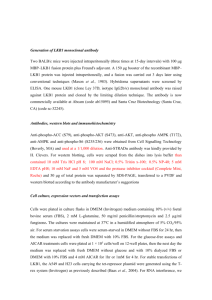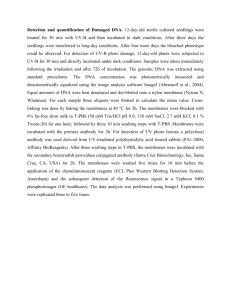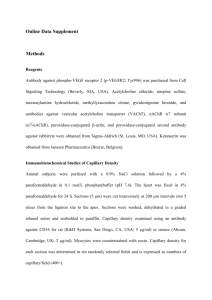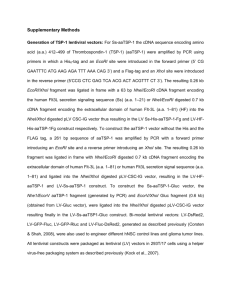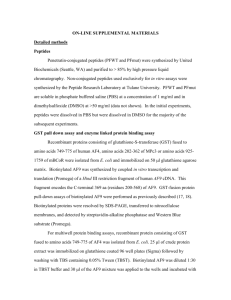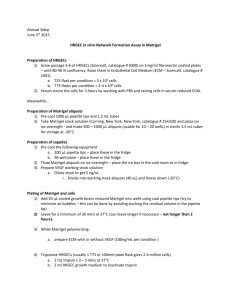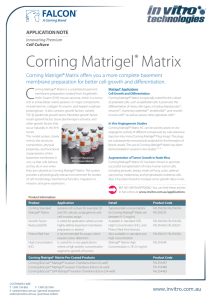HEP_26255_sm_SuppInfo
advertisement
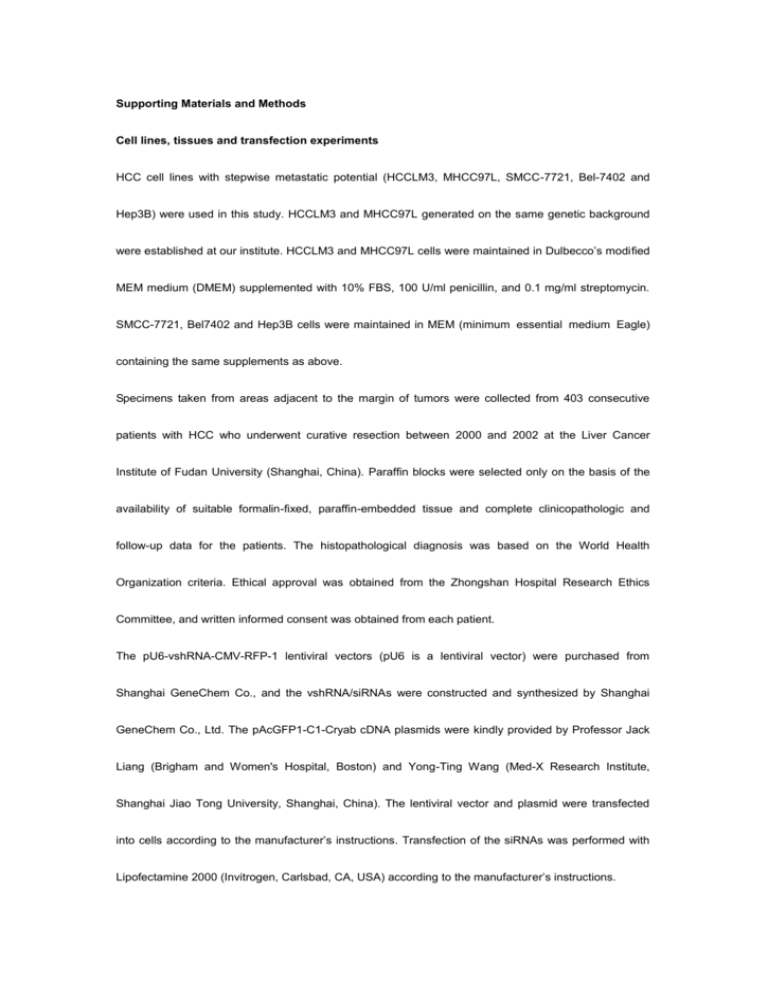
Supporting Materials and Methods Cell lines, tissues and transfection experiments HCC cell lines with stepwise metastatic potential (HCCLM3, MHCC97L, SMCC-7721, Bel-7402 and Hep3B) were used in this study. HCCLM3 and MHCC97L generated on the same genetic background were established at our institute. HCCLM3 and MHCC97L cells were maintained in Dulbecco’s modified MEM medium (DMEM) supplemented with 10% FBS, 100 U/ml penicillin, and 0.1 mg/ml streptomycin. SMCC-7721, Bel7402 and Hep3B cells were maintained in MEM (minimum essential medium Eagle) containing the same supplements as above. Specimens taken from areas adjacent to the margin of tumors were collected from 403 consecutive patients with HCC who underwent curative resection between 2000 and 2002 at the Liver Cancer Institute of Fudan University (Shanghai, China). Paraffin blocks were selected only on the basis of the availability of suitable formalin-fixed, paraffin-embedded tissue and complete clinicopathologic and follow-up data for the patients. The histopathological diagnosis was based on the World Health Organization criteria. Ethical approval was obtained from the Zhongshan Hospital Research Ethics Committee, and written informed consent was obtained from each patient. The pU6-vshRNA-CMV-RFP-1 lentiviral vectors (pU6 is a lentiviral vector) were purchased from Shanghai GeneChem Co., and the vshRNA/siRNAs were constructed and synthesized by Shanghai GeneChem Co., Ltd. The pAcGFP1-C1-Cryab cDNA plasmids were kindly provided by Professor Jack Liang (Brigham and Women's Hospital, Boston) and Yong-Ting Wang (Med-X Research Institute, Shanghai Jiao Tong University, Shanghai, China). The lentiviral vector and plasmid were transfected into cells according to the manufacturer’s instructions. Transfection of the siRNAs was performed with Lipofectamine 2000 (Invitrogen, Carlsbad, CA, USA) according to the manufacturer’s instructions. Cell Matrigel invasion assays, MTT assay and in vivo metastasis assays Cell invasion assays were performed using 24-well transwells (8 μm pore size; Corning) precoated with Matrigel (Falcon354480; BD Biosciences). A total of 1 × 10 5 cells were then suspended in 500 μl DMEM containing 1% FBS and added to the upper chamber, and 750 μl DMEM containing 10% FBS was placed in the lower chamber. After 48 h incubation, Matrigel and any remaining cells in the upper chamber were removed by cotton swabs. Cells on the lower surface of the membrane were fixed in 4% paraformaldehyde and stained with Giemsa. Cells in 5 microscopic fields (magnification, ×200) were counted and photographed. All experiments were performed in triplicate. Cells were aliquoted into a 96-well plate (2000 cells in 200 μl per well) and were incubated in medium supplemented with sorafenib (0, 1, 5, 10 or 20 μM) provided by Bayer Pharma AG (Berlin, Germany) for 24 h. Twenty microliters of 3-[4,5-dimethylthiazol-2-yl]-2,5-diphenyltetrazoliumbromide (MTT) bromide solution were added at the indicated time point, and the aliquots were incubated for 4 h. Medium was replaced with 150 μl of dimethyl sulfoxide, and the aliquots were shaken for 10 min. Absorbance at 560 nm was measured to determine the number of viable cells in each well. All experiments were performed in triplicate. The in vivo metastasis assays were performed using nude mice. Athymic nude mice were obtained from Shanghai Institute of Material Medicine and maintained in a pathogen-free environment. Animal care and experimental protocols were performed in accordance with the guidelines established by the Shanghai Medical Experimental Animal Care Commission. Ethical approval was obtained from the Zhongshan Hospital Research Ethics Committee. HCC cells were injected intrahepatically with a 27- gauge needle. At six weeks, six nude mice in each group were euthanized by anesthesia overdose and visceral organs, including the lungs and livers. Tissues were histopathologically examined and dehydrated/embedded in paraffin to generate serial sections. The tumor volume was calculated using the following formula: V = π / 6 × (larger diameter) × (smaller diameter)2. Lung metastases were examined and classified. H&E, Cryab, E-cadherin, Vimentin and Slug in vivo expression in excised tumors were examined in serial tissue sections. RNA expression analysis, Western blot Analysis, immunofluorescence assay and confocal immunofluorescence. Gene amplification and detection were performed using the ABI PRISM 7900 Sequence Detection System (Applied Biosystems, Foster City, CA, USA) starting with 1µl cDNA and SYBR Green Realtime PCR Master Mix (Takara, Japan). All transcript levels were normalized to Glyceraldehyde 3-phosphate dehydrogenase (GAPDH) expression. Each sample was tested in triplicate. The relative expression was analyzed by the comparative cycle threshold (Ct) method, according to the equation: 2 -ΔCt [ΔCt = Ct- Ct (GAPDH)]. Reaction products of semiquantitative PCR analysiswere run out on a 2% agarose gel for semiquantitative detection by autoradiography. All experiments were performed in triplicate. Protein extracts from cells were run on sodium dodecyl sulfate-polyacrylamide gel electrophoresis (SDS-PAGE), transferred onto polyvinylidene difluoride membranes, and incubated with the corresponding antibodies. The membranes were developed using the enhanced chemiluminescence method (Pierce, Rockford, IL, USA). Cells were permeabilized with 0.1% Triton X-100 for 15 min at room temperature, washed with PBS, and blocked with PBS containing 5% bovine serum albumin (BSA) for 1 h at room temperature. Cells were treated with antibody overnight at 4 ℃. Cells were rinsed with PBS and then incubated with secondary antibody for 1 h at room temperature. The slices were counterstained with diamidino phenylindole (DAPI) and examined using fluorescence microscopy (Leica Microsystems Imaging Solutions, Cambridge, UK). Immunoprecipitation (IP) assays Cells were washed twice with ice-cold PBS and then lysed with RIPA lysis buffer supplemented with complete protease Inhibitor (Roche). After removing the insoluble material by centrifugation 12,000×g, the precleared lysates were incubated with primary antibody pre-absorbed protein A- and G-Sepharose beads overnight at 4°C. The precipitates were washed with the lysis buffer five times, boiled in 5xSDS sample buffer for 5 min, and the proteins were resolved by SDS-PAGE on 10% gradient gels. Subsequent immunoblots were probed with the appropriate antibody and detected by ECL. Immunoisolation of Cryab-containing complexes, in-gel tryptic digestion and two-dimensional liquid chromatography coupled with tandem mass spectrometry (2D-LC-MS/MS) Immunoprecipitation was performed as described above. The solubilized extracts were then incubated with 50μl of protein A/G beads coupled to a rabbit anti-human monoclonal Cryab antibody at 4℃ overnight. The beads were then washed with lysis buffer five times, followed by boiling in 5× buffer. The immunoprecipitates were resolved on an SDS-PAGE denaturing gel, visualized by Coomassie blue staining, and the protein band of interest was removed for MS analysis. MS was performed under 19-kV accelerating voltage in reflection mode with an m/z range of 400 to 2,000. All MS/MS data were identified using SEQUEST (v.28, Bioworks 3.3 software package, Thermo Electron) against the Human International Protein Index (IPI) database (IPI human v3.45 FASTA with 71983 entries).
